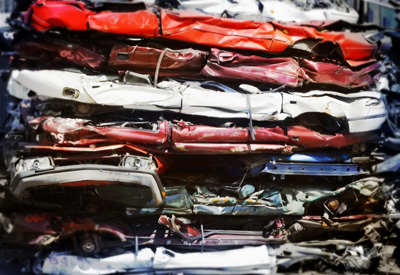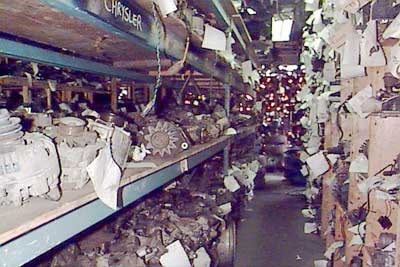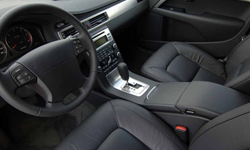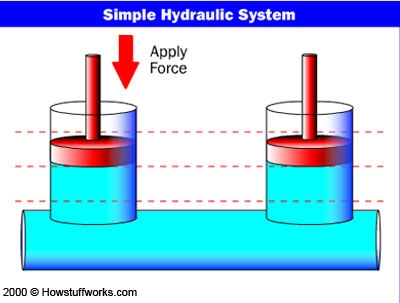 Image Gallery: Car Safety A bundle of crushed cars. See car safety pictures.
Image Gallery: Car Safety A bundle of crushed cars. See car safety pictures.
For every beginning there's an end. Every shiny new car on the showroom floor will one day end up in a junkyard, its value no greater than the weight of the metal used to build it. North American auto plants built 15.8 million cars in 2005 -- all of which have to end up somewhere [Source: Business Week]. One of the most important stops an old car reaches at the end of the line is the crusher -- a massive machine whose only purpose is to compress a car into a tiny cube or flattened slab.
In this article we'll learn what a car crusher is, how they crush and why take the time to turn a car into a brick of steel.
A car crusher is a piece of machinery used to compress the metal remains of a junked car after it has been stripped of all useful parts. Compressing them takes up less space when stored, or when transported via truck or train to a recycling facility. A crusher is just one step of the auto-recycling process. They can also be used to compact other forms of metal waste, such as old appliances or even large machines like combines.
 A car crusher
A car crusher
Crushers can be portable or stationary. Older machines tend to be stationary -- once they're set up in a scrap yard, they stay there. Today, most crushers are portable. They are built mounted to a standard-size truck trailer, and can be towed to various locations, set up, used to crush some things, then moved somewhere else. This helps cut costs for auto salvage yards - instead of buying an expensive machine, they can split the cost with other yards or rent time on a crusher that comes by once a week.
 Parts for resale after being stripped from a car.
Parts for resale after being stripped from a car.
Why do we need to crush cars? The most obvious reason is so they take up less space. But why are we scrapping, shredding and junking cars to begin with? Recycling cars is a lucrative business, and it makes environmental sense.
The sale of reusable salvage from old cars is only a small piece of the auto recycling pie. About 65 percent of a junked car is made from steel (the rest is made from other metals plus glass, rubber and upholstery). The price for scrap steel and iron, though volatile, often hovers around $250 per ton. Expanding economies in Asia have lead to greater demand for scrap steel, bolstering the market worldwide. With 14 million tons of steel from cars being scrapped each year contributing to an industry-wide total of 76 million tons of recycled steel and iron, it's easy to see that auto recycling is a multibillion dollar industry [Source: ISRI].
Recycling metal uses about 74 percent less energy than making new steel, according to the Environmental Protection Agency. Recycled steel is cheaper as well, since new ore doesn't have to be mined to produce it. All steel produced today has at least 25 percent recycled steel in it, and some products are made entirely from recycled steel. So in addition to the economic and environmental benefits, recycling cars is a vital link in the world's industrial infrastructure.
Once cars are crushed, they're shipped off to a recycling center where they are shredded and separated into small pieces, which are then sorted into various metals. The largest shredder in the world is used by Sturgis Iron & Metal of Elkhart, Indiana. The machine is so big, it isn't measured in tons, but acres. It uses an 8,000-horsepower electric motor to drive a massive rotor that spins hammers at 175 mph, reducing six pre-crushed cars per minute into fist-sized metal chunks [Source: Buffalo News]. The shredder is so powerful, the hammers must be turned or replaced almost daily because of the wear and tear they receive, and it sits on special dampeners to prevent seismic vibrations in the surrounding area.


Almost all modern car crushers use a hydraulic press to crush the cars. A large motor powers a pump that pushes hydraulic fluid to drive large cylinders. Using principles of force-multiplication, a hydraulic system can generate over 2,000 psi and impart more than 150 tons of crushing force onto a pile of scrap cars. For more details on hydraulic systems, read How Hydraulics Work.
In a "bale" crusher, another set of pistons pushes another crushing plate in a lateral direction. Once the car has been crushed flat, it's crushed sideways, forming a "hay bale" of compacted car. Some baler crushers use specially shaped "claws" that fold the cars into bales or square logs. You can view this diagram showing how this works.
In addition, an oil reclamation system sits below the crushing bed. When motor oil and other fluids drain from the crushed car, they run down into this system where they are collected and stored for later recycling.